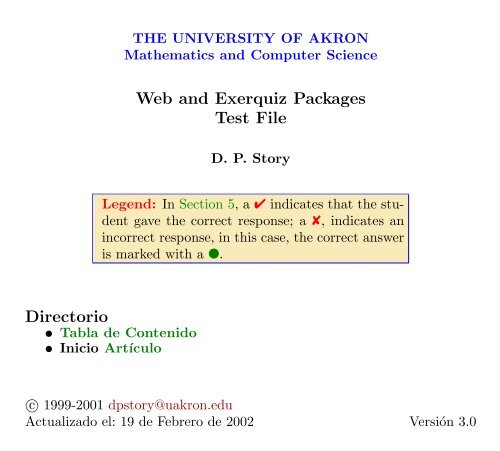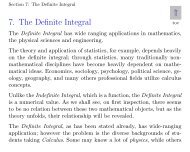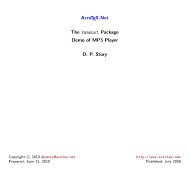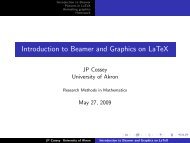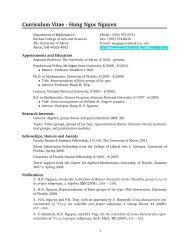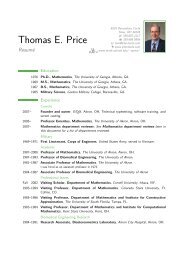Web and Exerquiz Packages Test File - Department of Mathematics ...
Web and Exerquiz Packages Test File - Department of Mathematics ...
Web and Exerquiz Packages Test File - Department of Mathematics ...
You also want an ePaper? Increase the reach of your titles
YUMPU automatically turns print PDFs into web optimized ePapers that Google loves.
THE UNIVERSITY OF AKRON<br />
<strong>Mathematics</strong> <strong>and</strong> Computer Science<br />
<strong>Web</strong> <strong>and</strong> <strong>Exerquiz</strong> <strong>Packages</strong><br />
<strong>Test</strong> <strong>File</strong><br />
D. P. Story<br />
Legend: In Section 5, a✔ indicates that the student<br />
gave the correct response; a ✘, indicates an<br />
incorrect response, in this case, the correct answer<br />
is marked with a ●.<br />
Directorio<br />
• Tabla de Contenido<br />
• Inicio Artículo<br />
c○ 1999-2001 dpstory@uakron.edu<br />
Actualizado el: 19 de Febrero de 2002 Versión 3.0
Tabla de Contenido<br />
1. Introduction<br />
2. On-Line Exercises<br />
3. Short Quizzes with or without Solutions<br />
4. Graded Quizzes with JavaScript<br />
5. Correcting Quizzes with JavaScript<br />
6. Objective-Style Questions<br />
Soluciones a los Ejercicios<br />
Soluciones a los <strong>Test</strong>s
Sección 1: Introduction 3<br />
1. Introduction<br />
This is a sample file to give templates <strong>of</strong> the environments defined in<br />
exerquiz.<br />
2. On-Line Exercises<br />
A well-designed sequences <strong>of</strong> exercises can be <strong>of</strong> aid to the student. The<br />
exercise environment makes it easy to produce electronic exercises. By<br />
using the forpaper option, you can also make a paper version <strong>of</strong> your<br />
exercises. See the <strong>Web</strong>eqman.pdf reference manual.<br />
<br />
Ejercicio 1. Evaluate the integral<br />
x 2 e 2x dx.<br />
In the preamble <strong>of</strong> this document, we defined a problem environment<br />
with its own counter. Here is an example <strong>of</strong> it.<br />
Problem 2.1. Is F (t) = sin(t) an antiderivative <strong>of</strong> f(x) = cos(x)? Explain<br />
your reasoning.<br />
Problem 2.2. Is F (t) = sin(t) an antiderivative <strong>of</strong> f(x) = cos(x)? Explain<br />
your reasoning.<br />
By modifying the exercise environment, you can also create an example<br />
environment. The one defined in the preamble <strong>of</strong> this document has no<br />
associated counter.
Sección 2: On-Line Exercises 4<br />
Example. Give an example <strong>of</strong> a set that is clopen.<br />
Solución: The real number line is both closed <strong>and</strong> open in the usual topology<br />
<strong>of</strong> the real line.<br />
<br />
There is a *-option with the exercise environment, using it signals<br />
the presence <strong>of</strong> a multiple part exercise question. The following exercise<br />
illustrates this option.<br />
Ejercicio 2. Suppose a particle is moving along the s-axis, <strong>and</strong> that its<br />
position at any time t is given by s = t2 − 5t +1.<br />
(a) Find the velocity, v, <strong>of</strong> the particle at any time t.<br />
(b) Find the acceleration, a, <strong>of</strong> the particle at any time t.<br />
References can be made to a particular part <strong>of</strong> an exercise; for example,<br />
“see Exercise 2(a).” Part (a) is in blue; the solutions for that part is<br />
“hidden”. This is a new option for the exercise environment.<br />
There is now an option for listing multipart question in tabular form.<br />
This problem style does not obey the solutionsafter option.<br />
Ejercicio 3. Simplify each <strong>of</strong> the following expressions in the complex<br />
number system. Note: ¯z is the conjugate <strong>of</strong> z; Rez is the real part <strong>of</strong> z <strong>and</strong><br />
Im z is the imaginary part <strong>of</strong> z.<br />
(a) i 2 (b) i 3<br />
(c) z +¯z (d) 1/z
Sección 3: Short Quizzes with or without Solutions 5<br />
3. Short Quizzes with or without Solutions<br />
Below is a shortquiz without solution.<br />
<strong>Test</strong>. Was it in Xanadu did Kubla Kahn a stately pleasure dome decree?<br />
(a) True<br />
(b) False<br />
Below is a shortquiz with a solution.<br />
<strong>Test</strong>. In what year did Columbus sail the ocean blue?<br />
(a) 1490 (b) 1491 (c) 1492 (d) 1493<br />
These two types can be bundled together using the questions environment.<br />
<strong>Test</strong>. Answer each <strong>of</strong> the following. Passing is 100%.<br />
1. Was it in Xanadu did Kubla Kahn a stately pleasure dome decree?<br />
(a) True (b) False<br />
2. In what year did Columbus sail the ocean blue?<br />
(a) 1490 (b) 1491 (c) 1492 (d) 1493<br />
Try using the pro<strong>of</strong>ing option <strong>of</strong> exerquiz. In this case, the correct<br />
answer is indicated to the side; useful, perhaps, for pro<strong>of</strong>-reading the document
Sección 4: Graded Quizzes with JavaScript 6<br />
4. Graded Quizzes with JavaScript<br />
You can create graded quizzes using the quiz environment.<br />
Here is a graded quiz using simple links. Might be suitable for a limited<br />
number <strong>of</strong> questions.<br />
Inicio del <strong>Test</strong> Using the discriminant, b2 − 4ac, respond to each <strong>of</strong> the<br />
following questions.<br />
1. Is the quadratic polynomial x2 − 4x + 3 irreducible?<br />
(a) Yes (b) No<br />
2. Is the quadratic polynomial 2x2 − 4x + 3 irreducible?<br />
(a) Yes (b) No<br />
3. How many solutions does the equation 2x2 − 3x − 2=0have?<br />
(a) none (b) one (c) two<br />
Final del <strong>Test</strong><br />
By using the *-option, you can create a multiple choice set <strong>of</strong> question<br />
using check boxes.<br />
Inicio del <strong>Test</strong> Using the discriminant, b 2 − 4ac, respond to each <strong>of</strong> the<br />
following questions.<br />
1. Is the quadratic polynomial x 2 − 4x + 3 irreducible?
Sección 5: Correcting Quizzes with JavaScript 7<br />
(a) Yes<br />
(b) No<br />
2. Is the quadratic polynomial 2x2 − 4x + 3 irreducible?<br />
(a) Yes (b) No<br />
3. How many solutions does the equation 2x2 − 3x − 2=0have?<br />
(a) none<br />
Final del <strong>Test</strong><br />
(b) one (c) two<br />
The pro<strong>of</strong>ing option <strong>of</strong> exerquiz can be used to mark the correct answer<br />
to the side; useful, perhaps, for pro<strong>of</strong>-reading the document<br />
5. Correcting Quizzes with JavaScript<br />
Beginning with version 1.2 <strong>of</strong> exerquiz, you can now grade the quizzes created<br />
by the quiz environment. In this section, we illustrate the quiz environment<br />
with corrections.<br />
There are two types: link-style <strong>and</strong> form-style. This is the link-style<br />
format:<br />
Inicio del <strong>Test</strong> Answer each <strong>of</strong> the following. Passing is 100%.<br />
1. Who created TEX?<br />
(a) Knuth (b) Lamport (c) Carlisle (d) Rahtz
Sección 5: Correcting Quizzes with JavaScript 8<br />
2. Who originally wrote LATEX? (a) Knuth<br />
Final del <strong>Test</strong><br />
(b) Lamport (c) Carlisle (d) Rahtz<br />
We can obtain the forms-style quiz simply by inserting an * before the<br />
quiz field name. Important! Be sure to name each quiz field differently!<br />
Inicio del <strong>Test</strong> Answer each <strong>of</strong> the following. Passing is 100%.<br />
1. Who created TEX?<br />
Knuth Lamport Carlisle Rahtz<br />
2. Who originally wrote LATEX? Knuth Lamport Carlisle Rahtz<br />
Final del <strong>Test</strong><br />
The “corrections” button can be modified to suite your needs. The quiz<br />
below queries your knowledge <strong>of</strong> the people who maintain various freeware<br />
TEX Systems for unix <strong>and</strong> Win95/98/NT. The corrections button has been<br />
modified to take on a different look.<br />
Inicio del <strong>Test</strong> Answer each <strong>of</strong> the following. Passing is 100%.<br />
1. What TEX System does Thomas Esser maintain?<br />
MikTEX csTEX teTEX fpTEX
Sección 6: Objective-Style Questions 9<br />
2. What TEX System does Fabrice Popineau maintain?<br />
MikTEX csTEX teTEX fpTEX<br />
3. What TEX System does Christian Schenk maintain?<br />
MikTEX<br />
Final del <strong>Test</strong><br />
csTEX teTEX fpTEX<br />
6. Objective-Style Questions<br />
Beginning with version 2 <strong>of</strong> <strong>Exerquiz</strong>, it is possible to pose objective-style<br />
questions (fill-in-the-blank). The demo file for this style question is called<br />
jquiztst.pdf (relative link: jquiztst.pdf). Click on the link to review this<br />
demo file.
Soluciones a los Ejercicios 10<br />
Soluciones a los Ejercicios<br />
Ejercicio 1. We evaluate by integration by parts:<br />
<br />
<br />
x 2 e 2x dx = 1<br />
2 x2 e 2x −<br />
= 1<br />
2 x2 e 2x −<br />
xe 2x dx u = x 2 , dv = e 2x dx<br />
<br />
1<br />
2xe2x <br />
1 −<br />
<br />
2 e2x dx<br />
<br />
integration by parts<br />
= 1<br />
2x2e 2x − 1<br />
2xe2x + 1<br />
2 e 2x dx u = x 2 , dv = e 2x dx<br />
= 1<br />
2x2e 2x − 1<br />
2xe2x + 1<br />
4e2x integration by parts<br />
= 1<br />
4 (2x2 − 2x +1)e 2x<br />
simplify!<br />
Ejercicio 1
Solutions to Problems 11<br />
Problem 2.1. The answer is yes. The definition states that F is an<br />
antiderivative <strong>of</strong> f if F ′ (x) =f(x). Note that<br />
F (t) = sin(t) =⇒ F ′ (t) = cos(t)<br />
hence, F (x) = cos(x) =f(x). ◭
Solutions to Problems 12<br />
Problem 2.2. The answer is yes. The definition states that F is an<br />
antiderivative <strong>of</strong> f if F ′ (x) =f(x). Note that<br />
F (t) = sin(t) =⇒ F ′ (t) = cos(t)<br />
hence, F (x) = cos(x) =f(x). ◭
Soluciones a los Ejercicios 13<br />
Ejercicio 2(b) Acceleration is the rate <strong>of</strong> change <strong>of</strong> velocity with respect<br />
to time. Thus,<br />
a = dv<br />
dt<br />
For our problem, we have<br />
a = dv<br />
dt<br />
d<br />
= (2t − 5)=2.<br />
dt<br />
The acceleration at time t is constant: a =2.
Soluciones a los Ejercicios 14<br />
Ejercicio 3(a) i 2 = −1
Soluciones a los Ejercicios 15<br />
Ejercicio 3(b) i 3 = ii 2 = −i
Soluciones a los Ejercicios 16<br />
Ejercicio 3(c) z +¯z =Rez
Soluciones a los <strong>Test</strong>s 17<br />
Soluciones a los <strong>Test</strong>s<br />
Solución al <strong>Test</strong>:<br />
In 1492,<br />
Columbus sailed the ocean blue.<br />
Pr<strong>of</strong>ound was the logic in his quest,<br />
to get to the east, he headed west. 1<br />
Final del <strong>Test</strong><br />
1 This poem was obtained by personal communication from Leonard A. Stefanski,<br />
<strong>Department</strong> <strong>of</strong> Statistics, North Carolina State University.
Soluciones a los <strong>Test</strong>s 18<br />
Solución al <strong>Test</strong>:<br />
In 1492,<br />
Columbus sailed the ocean blue.<br />
Pr<strong>of</strong>ound was the logic in his quest,<br />
to get to the east, he headed west. 2<br />
Final del <strong>Test</strong><br />
2 This poem was obtained by personal communication from Leonard A. Stefanski,<br />
<strong>Department</strong> <strong>of</strong> Statistics, North Carolina State University.


